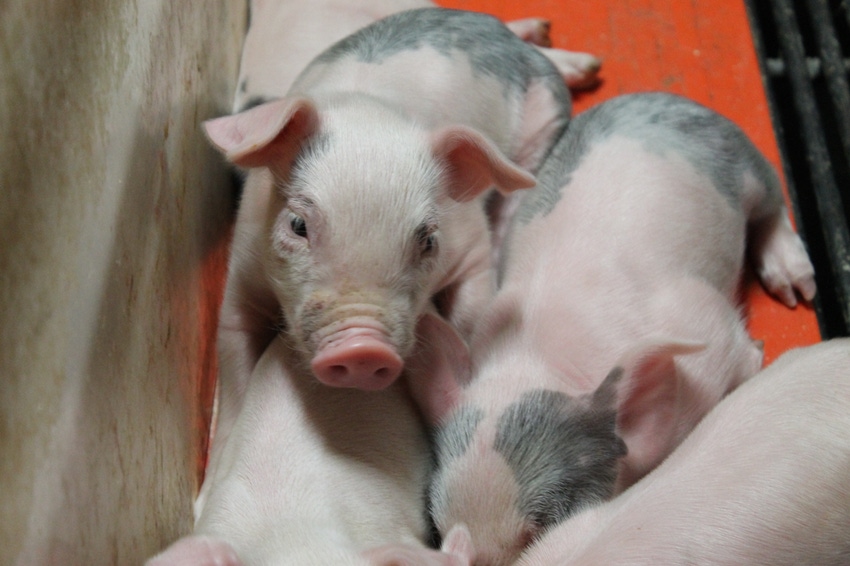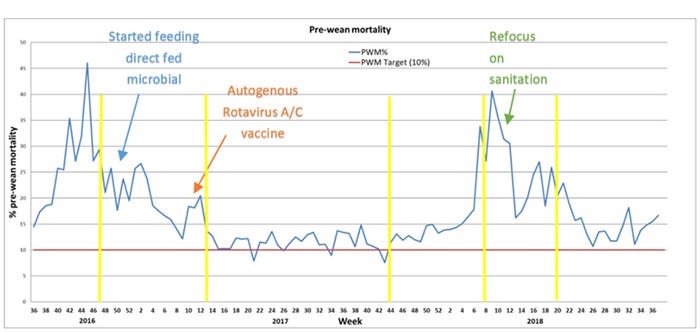A combination of accurate diagnostics and procedures conducted on the farm are essential to identifying effective approaches and technologies for solutions to pre-wean mortalities and piglet scours.
October 26, 2018

By Attila Farkas, DVM, Carthage Veterinary Service
Diarrhea in nursing pigs and associated elevated pre-weaning mortality can grow to be overwhelming for systems of all sizes. A combination of accurate diagnostics and procedures being conducted on the farm are essential to identifying effective approaches and technologies for solutions. Fixing baby pig diarrhea and associated elevated PWM might be straightforward allowing one intervention to provide long-lasting improvements in some situations, but most are complex and multifactorial requiring a program approach. The chronic nature of these issues in systems suggest that the focusing on one intervention only will not be successful. In most health challenges, viruses and bacteria cooperate to cause diseases which are more severe than those caused by either pathogen alone (Lecce et al., 1982). Rotavirus disease appears with watery diarrhea and is progressively less important with age. However, if pathogenic strains of E. coli are present, severe disease can occur with heavy prolonged mortality.
One recent example occurred at a large multiplication sow unit in the Midwest. This system has had periodic rotavirus breaks that has resulted in a high scour rate and elevated PWM. Farm specific RNA particle rotavirus vaccine and improved sanitation procedures have resulted in short-term improvements but scours and high piglet mortality would slowly climb back resulting in poor system performance, deflated employee morale, poor weaned pig quality and variation that drives problems through the entire downstream production.
In the most recent clinical outbreak of rotavirus and resulting increase in PWM (Figure 1), multiple interventions were put in place to address both the virus and the accompanying bacterial pathogens identified from additional diagnostics (Pathkinex, United Animal Health, Sheridan, Ind.) per rectal swabs. This tool proactively monitors for microbes associated with disease, but more importantly examines relationships between gut microorganisms, farm factors such as diet, sanitation, vaccination and management practices, and farm health to help producers achieve maximum performance results. It works by comparing groups of animals — deciphering the underlying microbial differences between them. This tool looks for connections between different microbes and significance to healthy, high-performing, sick or underperforming animals. This allows for focus and prioritization of key microbial populations. Data are then compared across a proprietary database to uncover unique differences between farms, spot emerging pathogen trends and identify the potential need for different product, diet, management or sanitation changes.

Figure 1: Weekly pre-wean mortality and initiation of strategies to reduce piglet mortality and scours. Weeks highlighted are when diagnostics were performed to determine rotavirus C and E.coli toxin gene quantities.
Rotavirus C was found to be elevated, but these diagnostics also indicated pathogenic E. coli with toxin genes were present, suggesting that intestinal bacteria were contributing to the clinical picture. Therefore interventions were put in place which included the use of farm-specific RNA particle vaccine, farm-specific autogenous killed Clostridium perfringens and E.coli vaccine, natural planned exposure using amplified rotavirus ice cubes, standard operation procedures driving sanitation, and the use of direct-fed microbials (Provent ECL, United Animal Health) to improve immunity against the active virus, reduce the environmental pathogen load, and improve the microbiota in the sows and piglets.
After these interventions were put in place, scour rate and PWM were reduced. In health monitoring, rotavirus C and E. coli toxin gene loads were reduced. These lower levels were maintained for approximately a year before the scours and mortality rates increased again (Figure 2). Initial belief was that the rotavirus C was driving this relapse. However, with diagnostics, rotavirus C levels were not found to be elevated but that bacterial toxin genes from E. coli were more diverse and extremely elevated compared to previous levels (Time P < 0.01). Digging deeper on the farm determined that sanitation protocols had not been maintained per SOP in the beginning of 2018, with reduced to no room sanitation being executed. Additional training and labor availability concerns were resolved, and the sanitation procedures returned to previous SOPs. Vaccines and direct-fed microbial feeding remained the same. Interestingly, PWM, scour rate and E. coli toxin genes were again reduced, but rotavirus C levels remained unchanged.

Figure 2: Rotavirus C and E. coli toxin gene quantification (K88, K99, F18, LT, STa, Stx1, Stx2, EaeA) over time in a 5,000-sow production unit. Interventions to reduce PWM and reduce rotavirus C infection were around the beginning of 2017. Winter of 2018 was a period with reduced sanitation due to labor shortages. Rotavirus C and E. coli toxin gene level over time P < 0.05.
The interventions utilized at this sow unit were successful in reducing PWM and piglet scours, with this unit currently running at a PWM rate that is close to target levels (Figure 1). Utilizing a multifactorial approach to improve both immunity and the microbiota in sows and piglets has resulted in a longer period of improved PWM than previous attempts where a singular intervention was employed. However, when sanitation was reduced, these interventions were covered up by a separate issue that resulted in similar clinical outcomes of high mortality and scours. The interaction between rotavirus C and pathogenic E.coli is not completely understood, but it is clear that focusing in on only one pathogen would have not led us to a solution at this unit. Diagnostics are key to finding what multiple pathogens may be contributing to an issue. If one truly wants to improve health and performance, identifying the contributing pathogens are necessary so that the right, multifaceted, system approach can be executed leading to success. Clinical diagnostics may come from a variety of laboratories, but using all tools for understanding the problem and monitoring on-farm compliance is essential if any interventions are going to be successful long term.
References
Lecce, J. G., Balsbaugh, R. K., Clare, D. A., & King, M. W. (1982). Rotavirus and hemolytic enteropathogenic Escherichia coli in weanling diarrhea of pigs. Journal of Clinical Microbiology, 16(4), 715–723.
You May Also Like



